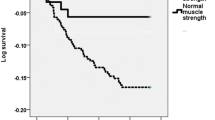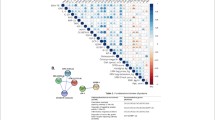Abstract
Background
Although low muscle function/strength is an important predictor of poor clinical outcome in older patients, information on its impact on mental health in clinical practice is still lacking.
Aims
The aim of this report is to measure the impact of low muscle function measured by handgrip strength on mental health of older people during both acute illness and recovery.
Methods
Four hundred and thirty-two randomly selected hospitalized older patients had their baseline demographic and clinical characteristics assessed within 72 h of admission, at 6 weeks and at 6 months. Low muscle strength-handgrip was defined using the European Working Group criteria. Mental health outcome measures including cognitive state, depression symptoms and quality of life were also measured.
Results
Among the 432 patients recruited, 308 (79%) had low muscle strength at baseline. Corresponding figures at 6 weeks and at 6 months were 140 (73%) and 158 (75%). Patients with poor muscle strength were significantly older with increased disability and poor nutritional status compared with those with normal muscle strength. After adjustment for age, gender, disability, comorbidity including severity of acute illness and body mass index patients with low muscle strength had worse cognitive function, quality of life and higher depression symptoms compared with those with normal muscle strength over a 6-month period (p < 0.05).
Conclusion
Poor muscle strength in older people is associated with poor cognitive state and quality of life and increased depression symptoms during both acute illness and recovery.



Similar content being viewed by others
References
Sayer AA (2010) Sarcopenia: a research agenda has been set, but recognition in clinical practice is lagging behind. BMJ 341:952
Cruz-Jentoft AJ, Baeyens JP, Bauer JM, Boirie Y, Cederholm T, Landi F, European Working Group on Sarcopenia in Older People et al (2010) Sarcopenia: European consensus on definition and diagnosis: report of the European Working Group on sarcopenia in older people. Age Ageing 39:412–423
Landi F, Liperoti R, Russo A, Giovannini S, Tosato M, Capoluongo E, Bernabei R, Onder G (2012) Sarcopenia as a risk factor for falls in elderly individuals: results from the ilSIRENTE study. Clin Nutr. doi:10.1016/j.clnu.2012.02.007
Frontera WR, Reid KF, Phillips EM, Krivickas LS, Hughes VA, Roubenoff R et al (2008) Muscle fiber size and function in elderly humans: a longitudinal study. J Appl Physiol 105:637–642
Goodpaster BH, Park SW, Harris TB, Kritchevsky SB, Nevitt M, Schwartz AV et al (2006) The loss of skeletal muscle strength, mass, and quality in older adults: the health, aging and body composition study. J Gerontol A Biol Sci Med Sci 61:1059–1064
Hughes VA, FronteraWR, Wood M, EvansWJ, Dallal GE, Roubenoff R et al (2001) Longitudinal muscle strength changes in older adults: influence of muscle mass, physical activity, and health. J Gerontol A Biol Sci Med Sci 56:B209–B217
Cesari M, Fielding RA, Pahor M, Goodpaster B, Hellerstein M et al (2012) Biomarkers of sarcopenia in clinical trials-recommendations from the International Working Group on Sarcopenia. J Cachexia Sarcopenia Muscle 3:181–190
Rantanen T, Guralnik JM, Foley D, Masaki K, Leveille S, Curb JD, White L (1999) Midlife hand grip strength as a predictor of old age disability. JAMA 281:558–560
Hicks GE, Shardell M, Alley DE, Miller RR, Bandinelli S, Guralnik J, Lauretani F, Simonsick EM, Ferrucci L (2012) Absolute strength and loss of strength as predictors of mobility decline in older adults: the InCHIANTI study. J Gerontol A Biol Sci Med Sci 67:66–73
Stenholm S, Rantanen T, Heliovaara M, Koskinen S (2008) The mediating role of C-reactive protein and handgrip strength between obesity and walking limitation. J Am Geriatr Soc 56:462–469
Fielding RA, Vellas B, Evans WJ, Bhasin S, Morley JE, Newman AB et al (2011) Sarcopenia: an undiagnosed condition in older adults. Current consensus definition: prevalence, etiology, and consequences. International working group on sarcopenia. J Am Med Dir Assoc 12:249–256
Abellan van Kan G, Cesari M, Gillette-Guyonnet S et al (2013) Sarcopenia and cognitive impairment in elderly women: results from the EPIDOS cohort. Age Ageing 42:196–202
Roubenoff R (2000) Exercise, sarcopenia, cognition and mood. In: Rosenberg IH, Sastre A (eds) Nutrition and ageing. Nestle Nutrition Workshop Series Clinical and Performance Program, vol 6. Basel, pp 151–162
Gariballa S, Alessa A (2013) Sarcopenia: prevalence and prognostic significance in hospitalized patients. Clin Nutr 32:772–776
Standardised Assessment Scales for Elderly People (1992) A report of joint workshops of the research unit of the Royal College of Physicians and the British Geriatrics Society. Royal College of Physicans and the British Geriatics Society, London, pp 24–27
Brazier JE, Harper R, Jones NMB, O’Cathain A, Thomas KJ, Usherwood T, Westlake L (1992) Validating the SF-36 health survey questionnaire: new outcome measure for primary care. BMJ 305:160–164
Roberts HC, Syddall HE, Sparkes J, Ritchie J, Butchart J, Kerr A, Cooper C, Sayer AA (2014) Grip strength and its determinants among older people in different healthcare settings. Age Ageing 43(2):241–246
Syddall H, Cooper C, Martin F, Briggs R, Aihie SA (2003) Is grip strength a useful single marker of frailty? Age Ageing 32:650–656
Sayer AA, Syddall HE, Martin HJ, Dennison EM, Roberts HC, Cooper C (2006) Is grip strength associated with health-related quality of life? Findings from the Hertfordshire Cohort Study. Age Ageing 35:409–415
Fukumori N, Yamamoto Y, Takegami M, Yamazaki S, Onishi Y, Sekiguchi M, Otani K, Konno S, Kikuchi S, Fukuhara S (2015) Association between hand-grip strength and depressive symptoms: locomotive syndrome and health outcomes in Aizu Cohort Study (LOHAS). Age Ageing 44:592–598
Burns JM, Johnson DK, Watts A et al (2010) Reduced lean mass in early Alzheimer disease and its association with brain atrophy. Arch Neurol 67:428–433
Howard C, Ferrucci L, Sun K, Fried LP, Walston J, Varadhan R, Guralnik JM, Semba RD (2007) Oxidative protein damage is associated with poor grip strength among older women living in the community. J Appl Physiol (1985) 103:17–20
Sousa AC, Zunzunegui MV, Li A, Phillips SP, Guralnik JM, Guerra RO (2016) Association between C-reactive protein and physical performance in older populations: results from the International Mobility in Aging Study (IMIAS). Age Ageing 45:274–280
Klein, Kinney J, Jeejeebhoy K, Alpers D, Hellerstein M, Murray M et al (1997) Nutrition support in clinical practice: review of published data. Am J Clin Nutr 66:683–706
Gariballa SE (2001) Malnutrition in hospitalised elderly patients: when does it matter? Clin Nutr 20:487–491
Acknowledgements
The index study was funded by The Health Foundation project grant. Thank-you to Dr. Sarah Forster for her help with data collection.
Author contributions
SG is the principal investigator, wrote the first draft, participated in the design of the study and performed the statistical analysis and writing of the final manuscript. AA helped with data entry and analysis and drafting of the manuscript. All authors read and approved the final manuscript.
Author information
Authors and Affiliations
Corresponding author
Ethics declarations
Conflict of interest
The authors declare that they have no financial or non-financial competing interest or conflict of interest.
Ethical approval
The study received local research ethics committee approval.
Informed consent
Informed consent was obtained from all individual participants included in the study.
Electronic supplementary material
Below is the link to the electronic supplementary material.
Rights and permissions
About this article
Cite this article
Gariballa, S., Alessa, A. Association between muscle function, cognitive state, depression symptoms and quality of life of older people: evidence from clinical practice. Aging Clin Exp Res 30, 351–357 (2018). https://doi.org/10.1007/s40520-017-0775-y
Received:
Accepted:
Published:
Issue Date:
DOI: https://doi.org/10.1007/s40520-017-0775-y




